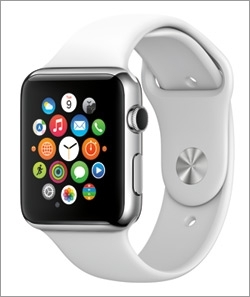Commentary
Apple Watch Grabs The Spotlight - But Can It Hold It?
- by Mark Walsh @markfwal, September 10, 2014

Among its trio of high-profile product announcements Tuesday, the Apple Watch may have delivered the biggest “Wow” factor, judging from the crowd reaction at the presentation as well as the response online. Unlike the iPhone 6 or Apple Pay, it’s trending on Twitter.
The wave of enthusiasm is hardly surprising, considering it marks Apple’s entrance into the wearables market and the first new hardware line it has launched since the iPad in 2010. Not least is that it’s a powerful computer housed in a piece of jewelry, with the attention to design aesthetics Apple has long been known for. Is the gold-plated model over the top?
advertisement
advertisement
Based on some hands-on time with the device yesterday, Consumer Reports noted the difference with existing smartwatches: "Many of them are plasticky, or bulky, or just plain ugly. Not the Apple Watch. It is a designed object, and a highly customizable one,” it stated in an initial review. Yahoo Tech Editor David Pogue, likewise, called it "much smaller and more beautiful than most previous smartwatches."
Its small frame also packs in plenty of functionality including serving as an extension of the iPhone and a fitness monitor, along with the ability to receive and make calls, message, access apps, and perform transactions using the same NFC technology now found in the new iPhone 6 models. And, oh yeah, tell time.
For brands and marketers, apps are clearly the way to gain a foothold on the Apple Watch. Apple announced Watchkit — a set of tools and APIs for developers to create “unique experiences” for the device — its answer to Android Wear. The company also highlighted some of the custom apps in the works including one from Starwood that would turn the watch into a room key and another from American Airlines for checking in and collecting luggage.
Other apps from Honeywell and Lutron would, respectively, allow users to adjust the thermostat or lighting in their homes by tapping on the device screen. Since the Apple Watch screen itself is hardly a canvas for branding, the emphasis across apps is squarely on utility. Even more than with smartphones, developers will have to focus on how they can make their apps useful to users on the go, and as streamlined as possible.
Although the Apple Watch will not be released until next year, analysts are already predicting it will redefine the smartwatch, and wearable category overall, much as the iPad did in the nascent tablet space four years ago. "Apple's Watch strategy, though not coming to a store near you soon, has firmly established the smartwatch as a new category,” stated James McQuivey, VP and principal analyst at Forrester.
That may well turn out to be the case. The larger question is just how big the market for smartwatches will be. Because the Apple Watch requires you to own an iPhone, that limits the market to the installed base of iPhone 5 and up users -- admittedly large -- but excludes the hundreds of millions of Android users. And starting at $349, the Apple Watch is an expensive iPhone accessory.
In terms of demand, Forrester estimates 42% of the U.S. online population is interested in using a wearable device on their wrist. A survey by research firm Analysys Mason found only 30% of U.S. consumers are interesting in buying a smartwatch. The arrival of the Apple Watch is likely to change perceptions, and spark new demand. But whether it will transform the smartwatch beyond a niche category isn’t a given.



